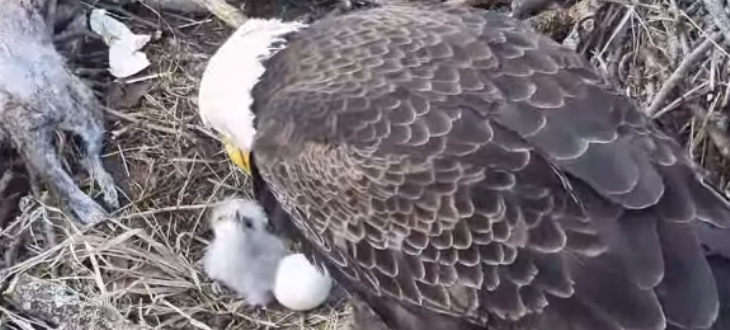The State We're In
Celebrating the recovery of bald eagles
In these uncertain and difficult times, we all need to look for signs of hope. Thanks to Mother Nature and a little help from her friends, here is a wonderful story of recovery and hope for New Jersey’s bald eagle population.
Two baby bald eagles just hatched at Duke Farms in Hillsborough – tiny fluff balls in a nest perched high in a sycamore tree. Though the nest is 80 feet above the ground in a remote area, thousands of people watched the eaglets breaking out of their shells, thanks to a webcam.
Congratulations poured in on social media as the babies hatched – yes, there’s even a Facebook page for the Duke Farms Eagle Cam! Followers worried whether the eaglets would survive chilly temperatures (they’re fine; their parents keep them warm), and whether the inexperienced eagle mom was letting the older chick hog the food (yes, but the younger chick is now catching up).
The new Duke Farms eaglets are the most famous members of the “Class of 2020” eagle chicks hatched in New Jersey this spring. If all goes well, they could be joined by another 250 or more eaglets throughout the state.
“This year we didn’t have a rough winter, so things are going pretty good as far as eggs hatching,” said Larissa Smith, biologist for the Conserve Wildlife Foundation of New Jersey and one of the leaders of the New Jersey Bald Eagle Project, which has tracked the state’s eagle population for over 35 years.
“About 20 or so chicks have hatched so far,” she added, with many other nesting pairs of eagles just starting to incubate their eggs.
And 22 or 23 new bald eagle pairs have been spotted this year, joining the 211 known pairs that nested or staked out territory in New Jersey in 2019.
This is great news for eagle fans – and another sign of progress in their remarkable comeback in New Jersey! Breeding bald eagles are still considered endangered in New Jersey, while non-breeding eagles are listed as threatened.
In of the middle of the last century, things looked bleak for our national symbol. Bald eagle populations nationwide plunged due to the pesticide DDT, which caused thin egg shells that broke easily. By 1970, New Jersey was down to one nesting pair.
DDT was banned throughout the United States in 1972, but bald eagles were slow to rebound. A decade after the ban took effect, this state we’re in still had only one nesting pair.
Things improved in the 1990s, thanks to the DDT ban and intervention by the state Division of Fish and Wildlife’s Endangered and Nongame Species Program. A graph of New Jersey’s bald eagle population over the past 32 years shows a steady upward climb.
Cumberland and Salem counties remain the state’s bald eagle stronghold, with by far the highest concentration of nests. But, according to Smith, eagles are slowly spreading into the northern half of the state. “Right now, they’re in every county except Essex,” she said.
Will New Jersey’s bald eagle population increase even more this year?
“It’s still too early to tell,” said Smith. “You never know what will happen when spring hits. One big storm could cause a lot of problems.”
At a time when dozens of bird species are declining throughout the Northeast, including New Jersey, the successful rebound of bald eagles gives hope for saving other species!
To learn more about bald eagles and watch the Duke Farms Eagle Cam, go to the Conserve Wildlife Foundation of New Jersey website at www.conservewildlifenj.org/education/eaglecam/.
One of last year’s Duke Farms eaglets – named “Duke” – was outfitted with a transmitter, and his movements can be tracked throughout his new territory near the Chesapeake Bay and Susquehanna River. To check out the EagleTrax program, go to www.conservewildlifenj.org/protecting/eagle-trax/. Unfortunately, Duke is the last remaining bald eagle currently being tracked; another eagle, Pedro, recently died from impact injuries.
To read the 2019 bald eagle report, go to www.state.nj.us/dep/fgw/ensp/pdf/eglrpt19.pdf.
And to learn more about preserving New Jersey’s land and natural resources – including bald eagle habitat – visit the New Jersey Conservation Foundation website or contact me at info@njconservation.org.
About the Authors
Alison Mitchell
Co-Executive Director
John S. Watson, Jr.
Co-Executive Director
Tom Gilbert
Co-Executive Director, 2022-2023
Michele S. Byers
Executive Director, 1999-2021
View their full bios here.
Filter
Get The Latest News
From The Garden State
In the
News

